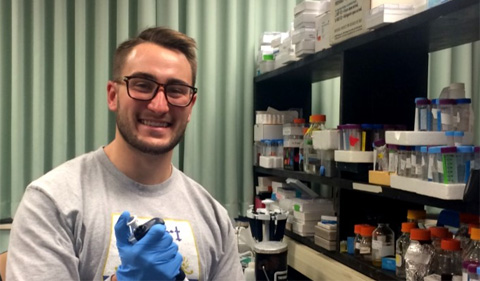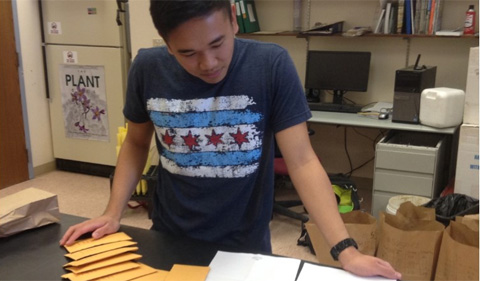By Sydney Dawes
Environmental & Plant Biology
Four students studying biology and plant biology received Provost’s Undergraduate Research Fund awards this fall.
The competitive awards, first offered in 2001, support students working with a faculty member on an independent project. Students can receive up to $1,500 and are required to participate in the annual Research and Creative Activity Expo held each Spring.
Researching How Hyp-GALT Enzymes Influence Plant Growth
Junior Chase Hudak, a Biology-Pre Med major, recently began working with Dr. Allan Showalter for his PURF project. Hudak has been awarded $900 for his project, “Phenotypic Characterization of Hydroxyproline-Galactosyltransferase (Hyp-GALT) Mutants with Altered Glycosylation of Arabinogalactan-Proteins in Arabidopsis.”
His role is to grow both wild and Hyp-GALT mutant Arabidopsis seeds and then record phenotypic differences—root length, flowering, height, number of seed pods—to examine how the Hydroxyproline-Galactosyltransferase enzymes influence plant growth and development.
He is currently involved in research on the structure of cell walls and the function of Hyp-GALTs, which are responsible for sugar addition to arabinogalactan-proteins.
Discovering Species Evolution in Complex Violet Group
Senior Kyle Gatt, working with Dr. Harvey Ballard Jr., began research on the Viola subsinuata species group this past summer while he was in Canada.
A senior Wildlife and Conservation Biology major with a plant biology minor, Gatt hypothesizes that this species of violet actually contains at least three cryptic species (plants that look similar, but are distinct genetically) in addition to a widespread one.
“There’s very little geographic overlap between the three, because there’s the Great Lakes type, there’s the Appalachian type, and then there’s the Virginia plateau type,” he said. “Then there’s hybrids around them that hybridize with other species, or the other species that they’re hybridizing with are found in all three of those geographical regions.”
Gatt received $1,323 for his project, “Species Discovery and Evolution in a Complex Violet Group,” to examine all the species detected in the Viola subsinuata species group physically and genetically.

Jeremy Held ’17, who interned at Vinton Furnace Experimental Forest, will examine genetic diversity of ash trees before and after the Emerald Ash Borer next summer.
Examining Genetic Diversity of Ash Trees Before, After Borer
Junior Jeremy Held, an Honors Tutorial College Plant Biology major, became interested in ecological research while he was interning with U.S. Forest Service at Vinton Furnace Experimental Forest this past summer. He contacted Dr. Jennifer Koch, a scientist hoping to develop a variety of ash trees that is resistant to the emerald ash borer, and asked to participate in her research.
His research will be under the guidance of Dr. Harvey Ballard Jr., and he begins his work on the project in the summer planting ash trees in the Ohio University Greenhouse for his research. The bulk of his PURF award will be used to examine genetic diversity of plant tissue previously collected from the entire ash population before it was decimated by the Emerald Ash Borer, and to compare that with the diversity of a small grove of ash that were “resistant” to the borer.
Held, who received $1,426 from his PURF award, is hoping not only to gain experience in data analysis, but also to explore what he would like to study in grad school.
Identifying Peanut Varieties That Improve the Soil
Sophomore Jordan Francisco, an Environmental & Plant Biology major, got the idea for his PURF project, “The Nitrogen Fixation Efficiency among Peanut Cultivars,” while working for Dr. David Rosenthal as a PACE student.
“Dr. Rosenthal’s research right now focuses on sweet potatoes. He’s looking at different varieties and seeing which grow best in Ohio, and I kind of got the idea from that. I’m really interested in legumes,” Francisco said. Legumes, such as peanuts, alfalfa and soybean, have symbiotic associations with bacteria. The bacteria convert nitrogen in the air into organic nitrogen that plants need to grow. Legumes also add nitrogen to the soil which improves soil quality.
Francisco will identify peanut varieties that most improve the soil. Most of his research will take place this spring and summer. Francisco is receiving $584 for his project.






















Comments